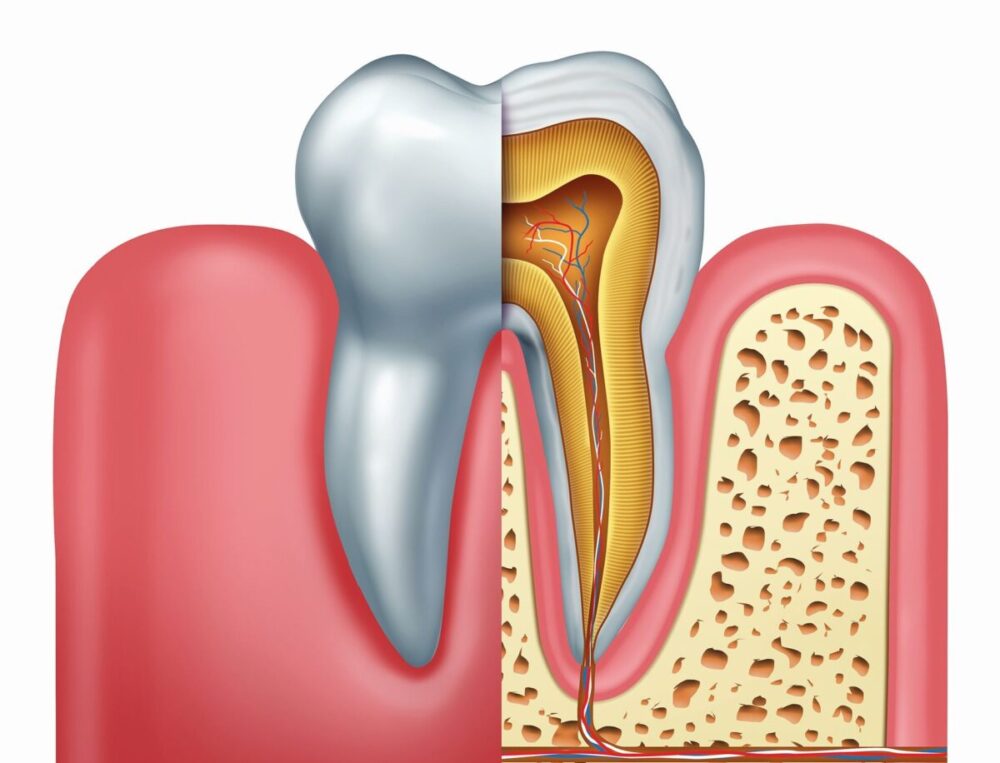
The journey from the first pang of a toothache to deciding on the path of a root canal can be fraught with pain, anxiety, and a multitude of questions. Exposed tooth nerves and consequent toothaches serve as a wake-up call, prompting individuals to seek professional dental intervention.
Unmasking the Source: Exposed Tooth Nerves
Exposed tooth nerves can originate from various dental issues, causing significant discomfort and pain to an individual. Enamel erosion due to acidic foods, aggressive brushing, or grinding can expose the dentin, leading to increased sensitivity. Physical injuries, such as chipped or broken teeth, may also unveil the nerve, subjecting it to the external environment. Cavities that progressively decay the tooth structure until reaching the nerve, too, result in acute pain. Additionally, receding gums, often due to periodontal disease or improper brushing techniques, may expose the tooth roots, prompting sensitivity and potential further complications. Thus, understanding the source is pivotal in formulating an effective treatment plan.
Signs that Ring Alarms: When Do You Need to See a Dentist?

Ignoring oral discomfort isn’t advisable. Persistent pain, increased sensitivity, swelling, or a pimple-like bump on the gum are red flags, hinting that your dental plight may have transcended mere sensitivity, stepping into the realm where immediate professional attention from a dentist or a root canal specialist is warranted.
Bridging the Gap: The Journey from Toothache to Root Canal
Root canals are often surrounded by apprehensions and myths, primarily related to pain and procedural woes. When an exposed nerve or a severely damaged tooth spells trouble, dentists weigh the condition, exploring restorative paths that could either save or extract the tooth. If saving it aligns with optimal oral health, a root canal becomes a viable option. A root canal specialist in Miami explains that the procedure entails removing the infected or inflamed pulp, cleaning, and sealing the inside of the tooth, thus preserving it.
Pulling Back the Curtains: What to Expect during a Root Canal

Navigating through the often-misunderstood journey of a root canal can be smoother with a basic understanding of the procedure.
Step 1: Evaluation and X-ray
The pathway to a root canal begins with a comprehensive evaluation of the affected tooth, often involving an X-ray to gain insights into the tooth’s root canals and observe the extent of damage to the surrounding bone.
Step 2: Anesthesia Application
Contrary to popular belief, a root canal is not a painful ordeal. Local anesthesia is administered to numb the tooth and its surrounding area, ensuring the procedure is as painless as possible.
Step 3: Creating an Access Point
The dentist then places a rubber dam around the affected tooth to keep it dry and debris-free. An opening is created on the tooth’s crown to access the pulp chamber and root canals.
Step 4: Removing Infected Pulp
Infected or dead pulp present in the root canals is meticulously removed. This is pivotal to prevent further infection and save the tooth from extraction.
Step 5: Cleaning and Shaping the Canals
Post pulp-removal, the canals are cleaned and shaped to facilitate the subsequent filling and sealing process. Occasionally, medications may be placed to eradicate any lingering infection.
Step 6: Sealing the Canals
After ensuring the canals are infection-free and shaped correctly, they are sealed with a biocompatible material, often gutta-percha, to prevent future infection.
Step 7: Restoration of the Tooth
Finally, restoration through a crown or filling is undertaken to reinstate the tooth’s functionality and aesthetic appeal.
Post Procedure
Post-procedure, it’s not uncommon to experience some discomfort, which is typically manageable with over-the-counter pain medications. A follow-up appointment may be scheduled to assess the healing process.
Is the Path of Root Canal Universal?
Each dental predicament is unique, thus mandating a tailored approach. While root canals serve as a beacon of relief for many, alternative treatments might be recommended based on the condition and health of the tooth and surrounding tissues. From extractions followed by dental implants to pulp capping in cases where the nerve is still healthy, numerous routes can navigate one towards oral health.
Insurance and Root Canals: Navigating Financial Aspects

“Does insurance cover root canal?” is a common query encountered by dental practitioners. The answer leans on the specifics of your dental insurance plan. Some policies might cover a part of the procedure, while others could provide comprehensive coverage. A transparent discussion with your dental office and insurance provider will unveil the financial facet, allowing you to plan your treatment without monetary surprises.
Conclusion: A Healthy Mouth is a Happy Mouth
Embarking on the journey from a toothache to treatment necessitates a thorough understanding, a seasoned specialist, and a patient-centric approach that envelopes not just the procedure but pre-and post-procedural care as well. The aim remains to preserve not just the tooth but the overarching oral health, ensuring that your smile remains undeterred and unabashed.
Your pursuit of dental health, especially when it pivots around complex procedures like root canals, should be navigated with adequate knowledge and specialist intervention, ensuring that every step taken is in the right direction towards maintaining a healthy, happy mouth.








